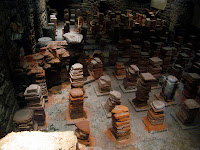 The journey to ancient civilizations may be back home, but it's not over. This photo looks east along a ridge of the Santa Ynez Mountains separating Santa Barbara from Egypt, Greece and Rome. Ok, that;s a little dramatic, but this point does mark the halfway point on our Outdoor School nine-mile hike. I just got back from a week of science camp with my students at ODS Rancho Alegre. I couldn't recommend the program more. We hiked, played, learned about geology, botany, biology, and the Native American Chumash culture of the area, and then hiked some more. Oh yeah, and it was tons of fun. Buzzard, the director, really understands kids and education.
The journey to ancient civilizations may be back home, but it's not over. This photo looks east along a ridge of the Santa Ynez Mountains separating Santa Barbara from Egypt, Greece and Rome. Ok, that;s a little dramatic, but this point does mark the halfway point on our Outdoor School nine-mile hike. I just got back from a week of science camp with my students at ODS Rancho Alegre. I couldn't recommend the program more. We hiked, played, learned about geology, botany, biology, and the Native American Chumash culture of the area, and then hiked some more. Oh yeah, and it was tons of fun. Buzzard, the director, really understands kids and education.  On the last night of camp he asked me to present my sabbatical travels to his staff after we got all 112 of the students down to sleep, a wild task in and of itself. So around 11:00 pm we broke out the bread, cheese, prosciutto, and wine, and I gave them the virtual photo tour. Three days later I gave the tour to our dear friends Dewitt and Dorothy Jayne. Dewitt and Dorothy are in their 90's and are responsible for inspiring me to dream of going to Egypt in search of his early Exodus story. I will be doing it again for a group of supporters in the next few weeks. The journey marches on.
On the last night of camp he asked me to present my sabbatical travels to his staff after we got all 112 of the students down to sleep, a wild task in and of itself. So around 11:00 pm we broke out the bread, cheese, prosciutto, and wine, and I gave them the virtual photo tour. Three days later I gave the tour to our dear friends Dewitt and Dorothy Jayne. Dewitt and Dorothy are in their 90's and are responsible for inspiring me to dream of going to Egypt in search of his early Exodus story. I will be doing it again for a group of supporters in the next few weeks. The journey marches on.Last month I had all 112 sixth grade students at our school recreate the ten-minute video I put together chronicling ancient cultures of the Lascaux cave dwellers, the Egyptians, the Greeks and the Romans. Using iMovie and iDVD students imported my narration and video clips, added a few transitions and titles, and voila! They had their own video to take home and share with their families. It turned out nicer than I thought. Here is the blog link to the movie I made myself.
We also completed our first real social studies unit on early human cultures. I decided to record my students singing "The Early Human Song." Megan and I wrote this song several years ago while playing around with ways to teach vocabulary to our students. The tune is a lousy rip-off of Dylan's "Blowing in the Wind." The students are appropriately loud and obnoxious as the sing. I'm not sure that Zimmy could sound any worse. It's lots of fun and it gets at the basics. I have also included the lyrics in case you couldn't quite make them out. Enjoy!





















































